How to Find Wholesale Suppliers and Negotiate Profitable Deals for Your Amazon Store

Trifon Tsevtkov
May 19, 2019 Updated on October 13, 2019
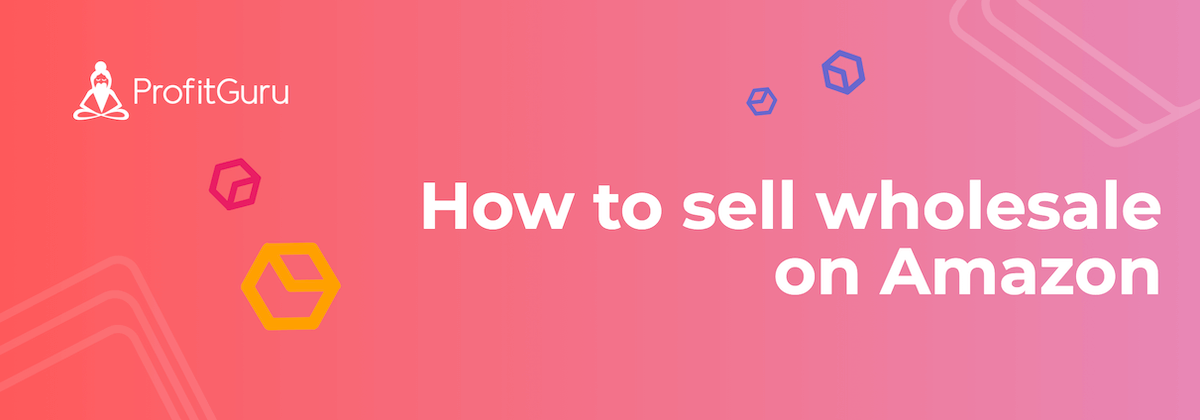
You may have heard about many Amazon success stories using the wholesale sourcing method.
Indeed, we also think it’s one of the best ways to start and grow your Amazon store.
But as with anything else worth pursuing, building a profitable venture using the wholesale method involves hard work.
There are many obstacles in the way not just for new sellers but for even established Amazon business owners.
So why is that?
First, it may be hard to understand the Amazon seller supply chain. Should you partner with low-tier wholesalers? Or maybe you should try and work with brand owners directly?
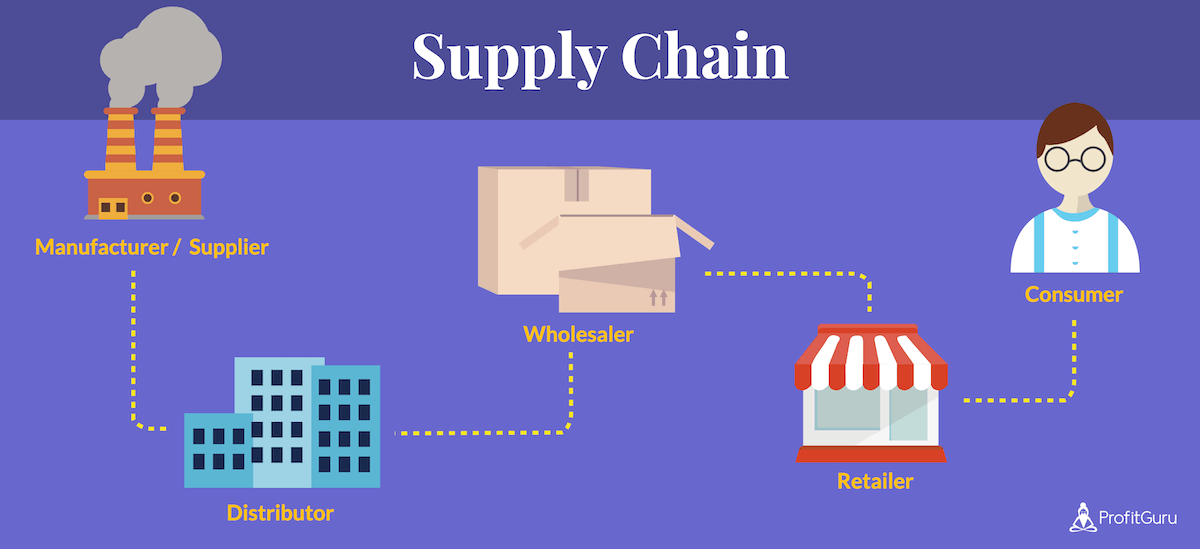
Second, finding a decent supplier can be a daunting task. Where do you start your search? And how do you avoid getting lost in the information or being ripped off by “companies” who pretend to be something they are not?
Finally, even if you know a good supplier who wants to do business with you, how do you negotiate the best possible deals? Ultimately, your costs will determine if you make a profit or loss at the end of the year.
These are the questions we’re going to answer in this guide, aiming to help both novice Amazon sellers and entrepreneurs with some experience under their belt build a successful wholesale business on Amazon.
Ready? Let’s go.
The Amazon wholesale supply chain for sellers
When investigating sources to purchase stock, you will come across the supply chain which, in its most basic form, is Manufacturer/Brand Owner > Wholesaler.
You will pay more for the stock from a low tier wholesale than you would from the manufacturer/brand owner, but it is advisable that you start your Amazon business by purchasing stock in this way.
More often than not it is easy to open an account, and you will get access, in some cases, to thousands of products which you can sell.
From your initial sales, you will be able to determine which brands sell well, and you will be able to investigate ways to bring the cost and price of these brands down in order to make a greater profit.
Just breaking even during the early stages of your business is good enough, but you will find that as you gain experience, your business will become more profitable.
The biggest disadvantages of working with these low tier wholesalers are that the price you pay will not be the most competitive as it is not difficult to open an account with them. With that, the competition will usually be higher.
Your ultimate goal should be to move up the supply chain from buying wholesale to buying from the manufacturer or brand owner. The cost, price and the competition will be lower which will yield greater profits for you.
How do you know if a supplier is good?
You should be aware that most of the best potential suppliers are those who say NO when you first enquire about opening an account with them.
They usually give the excuse that they don't do business with Amazon sellers, but if you see other Amazon sellers selling their products (which is not as rare as you might expect), there will probably be a chance that you can persuade them to do business with you.
How can you do that? By providing value to them ahead of time.
Things such as optimizing the existing Amazon listing, creating better product photos and descriptions or giving another service for free can go a long way when building relationships with good suppliers.
If you make the effort to do these extra steps (which most sellers won't) and open an account with a strong supplier, you could enjoy high profits with low competition for a very long time.
How to find a wholesale supplier for your Amazon store
Ok, so now that we’ve had a look at how the overall supply chain works, let’s explore finding suppliers for your Amazon store.
There is a common misconception amongst new sellers that wholesale suppliers are in some way doing you a favor by agreeing to do business with you.
Nothing could be further from the truth and any reason they give for not doing business with you can often be overcome.
If you are wondering how to find a reliable supplier, there are lots of methods to find wholesalers and most commonly you are only limited by your imagination.
But first, here’s a word of caution for new sellers:
There are some wholesalers out there who may not be as credible as they would like you to think they are. Don't even think about investing large sums of money if you haven't taken precautions to ensure that the wholesaler is legitimate.
Ask for their business details such as their company registration number and check with places like the Better Business Bureau.
Also, check if the supplier has a warehouse where they physically store products. There are many fake suppliers who have nice websites but don't actually have any products. Often they get their list of products from the real suppliers, add their markup, and then pass your order to the real supplier.
It may seem like a lot of work to find these details about a company who you might not even end up doing business with. However, if you don't take these steps you may find that it could be a business mistake you will never forget.
Now, let’s look at some tried and tested methods for finding great suppliers.
Start with a simple Google search
A good place to start is by carrying out a Google search for “[insert your product niche] trade shows [insert your Country or Region]”.

If you are able to visit a trade show, you will no doubt come across wholesalers who you would like to do business with, but you will also find that trade show websites will list their exhibitors, usually with a link to their websites.
Another method which seems a little too obvious is to carry out a simple Google search for wholesalers of the type of product you require, for example:

This should give you a good starting point of suppliers to choose from. However, you’ll soon find that researching and creating your own database of suppliers is a very time consuming process.
This is where tools like ProfitGuru can help.
Use ProfitGuru to streamline the process
The ProfitGuru tool has been designed so that it can serve as a general supplier directory, but its real strength is identifying brands and products which are doing well and then finding wholesalers from that information.
Based on Amazon metrics, the tool will take into account which products have the best potential. So instead of finding a wholesaler and then looking at the products they have in stock, you can look for the best sellers and then see which wholesaler stocks them. Here’s an example:
Once you log in to ProfitGuru, select the Products section and click the “Advanced Filter” link.
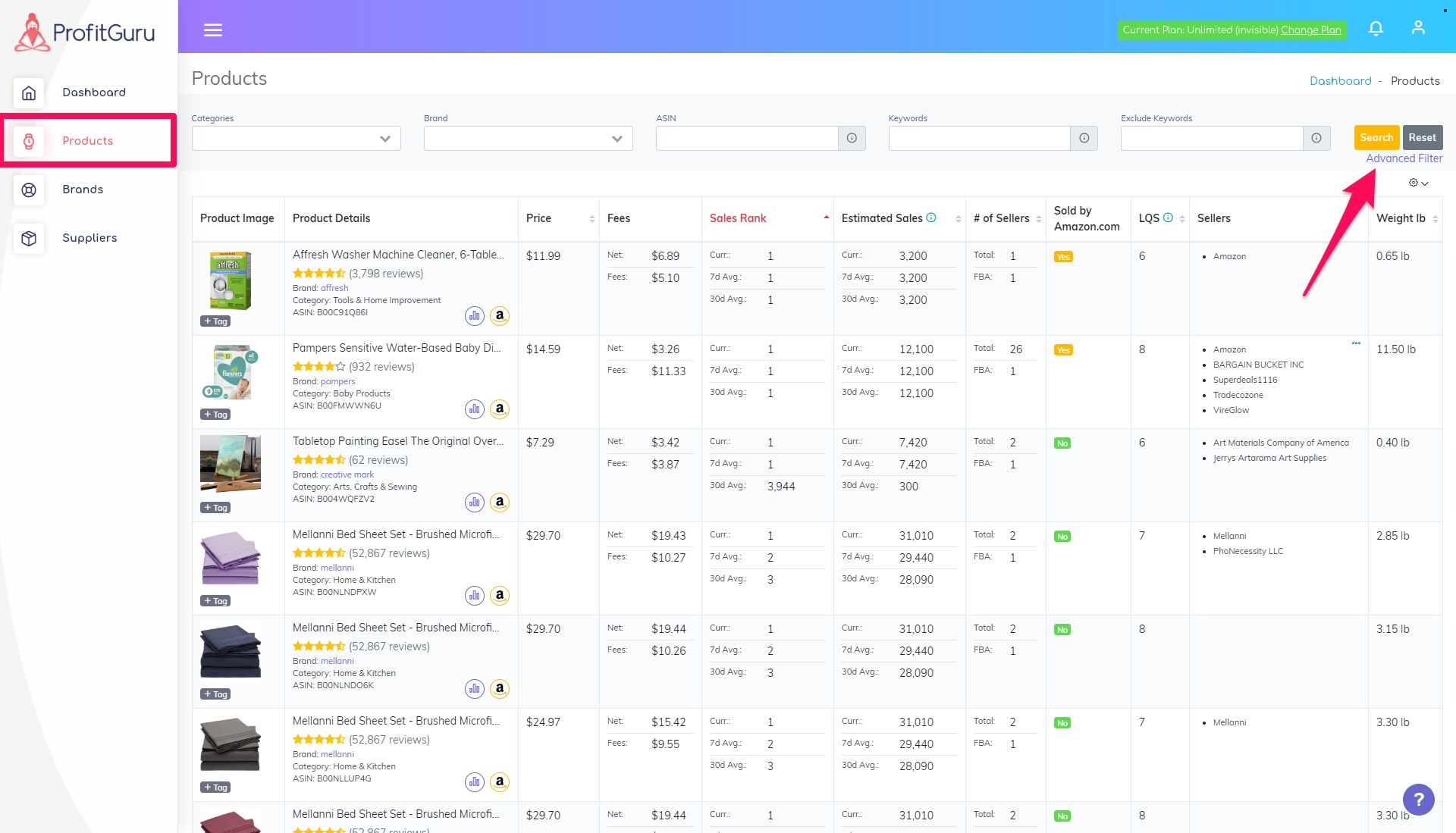
Let’s say we’re looking for products in the Home & Kitchen category that are selling well. Select the relevant category and enter a minimum monthly sales volume, say 100, and hit “Search”.
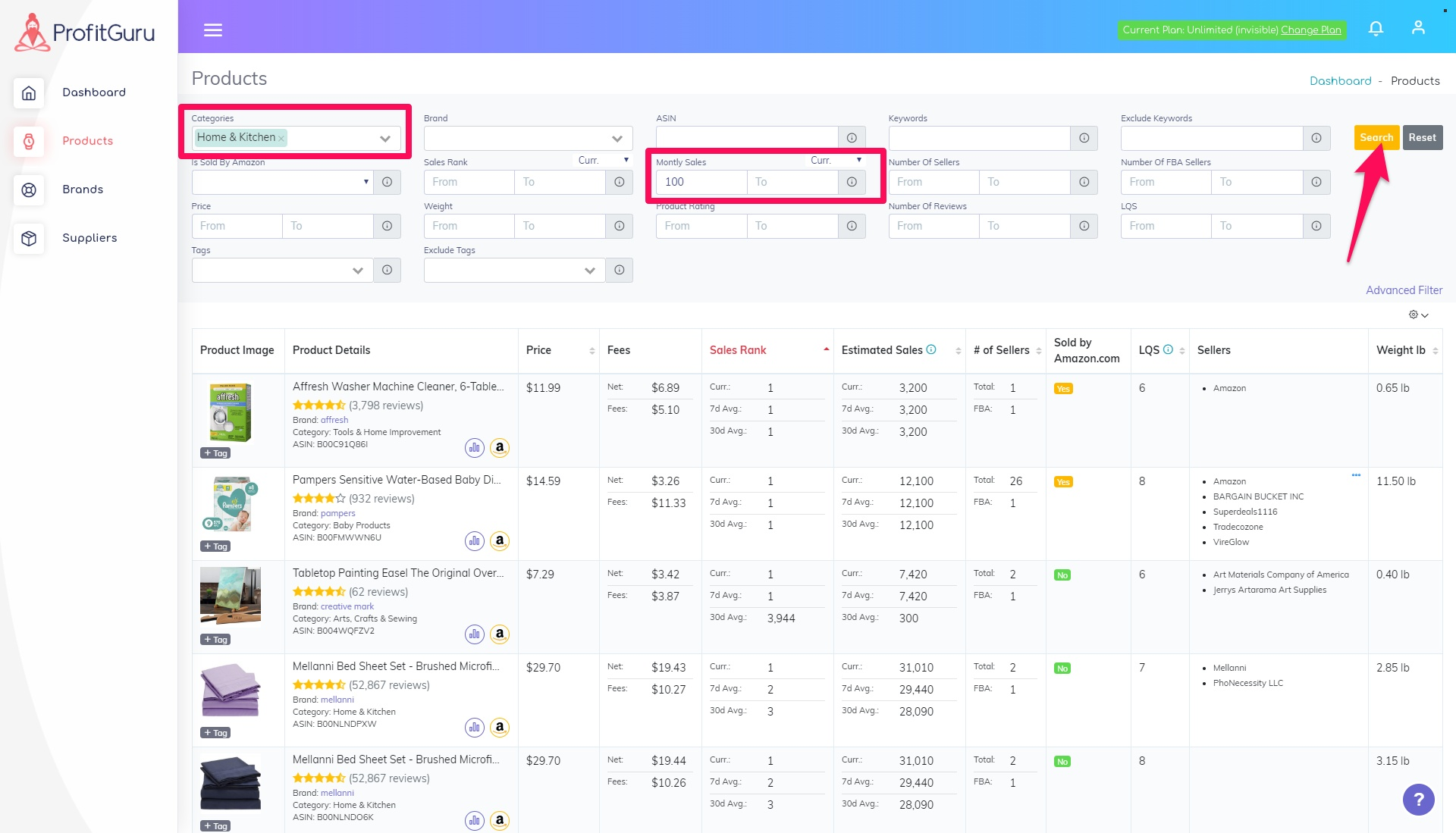
This will yield thousands of products so we’ll narrow down using a few extra factors. Namely, we’re going to look for products that are not sold by Amazon directly (to avoid competing with them) and we’ll make sure there are between 7 and 10 sellers for each listing. This way, you’ll know the demand for the product is good enough to justify multiple sellers, yet competition is not too high.
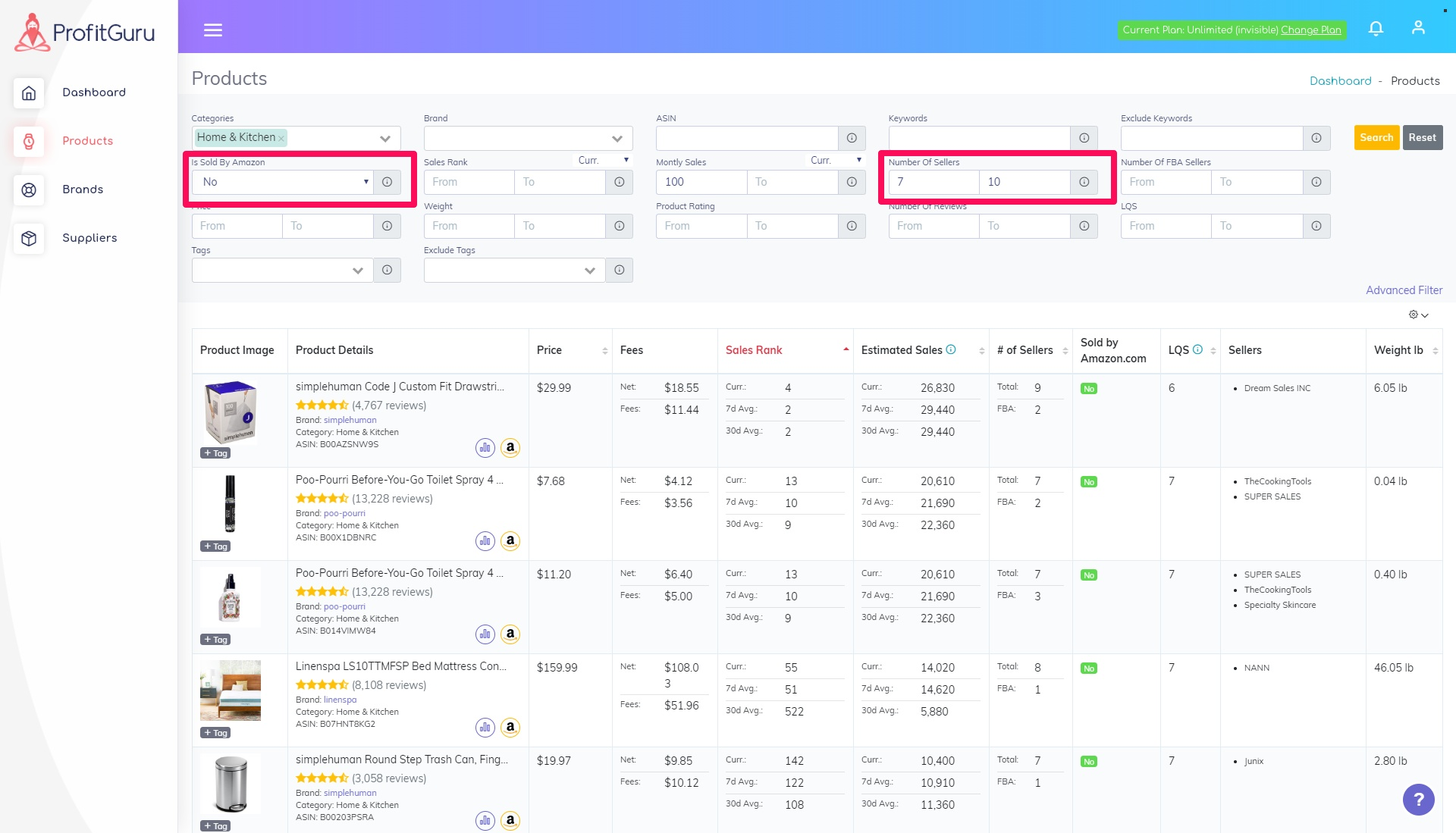
This will give you a more manageable list of products to review.
Once you find an interesting product, click on the brand name in the summary box to get more details about the brand.
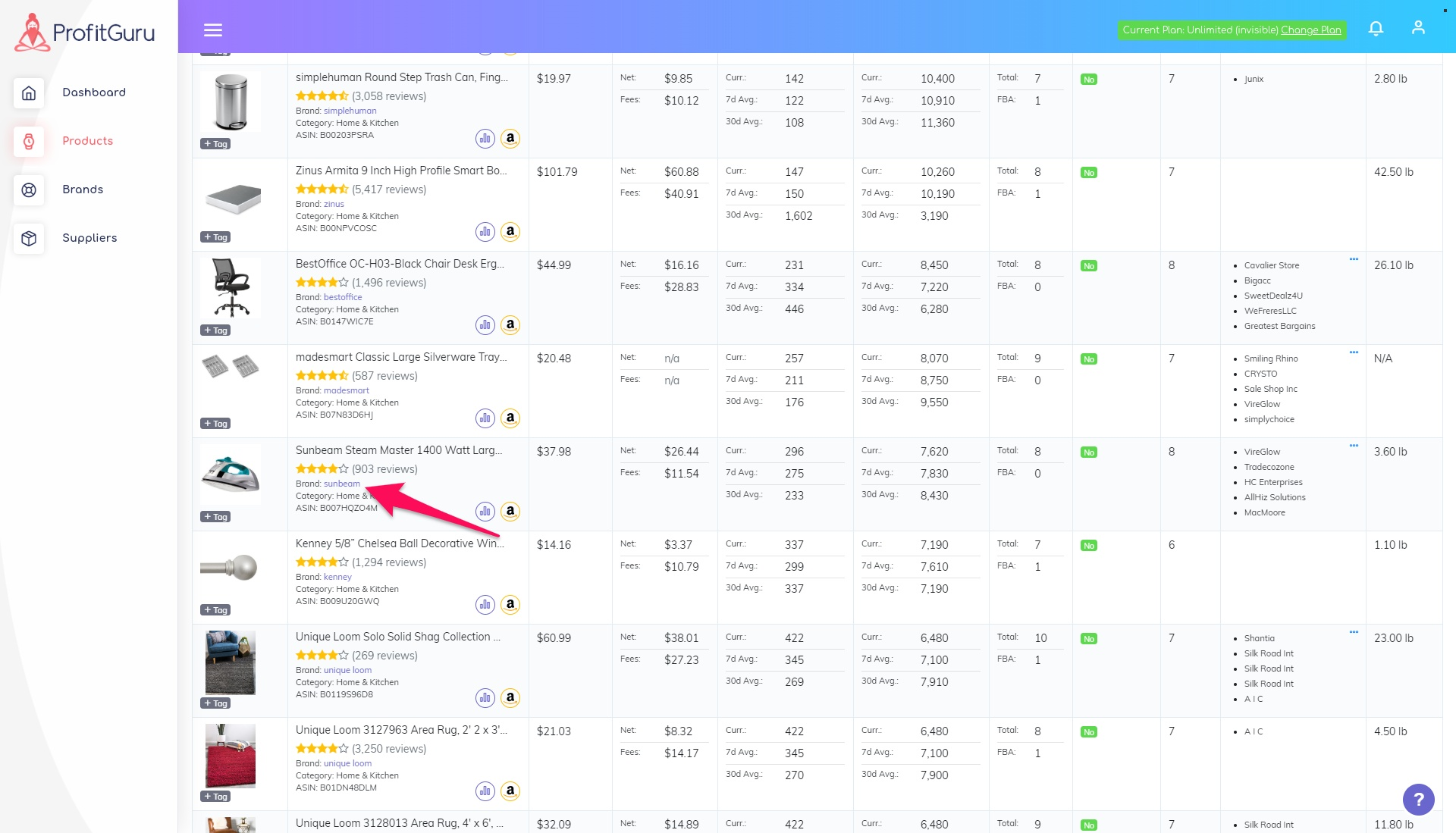
The Brand page will give you lots of useful information about their products and sellers. On the right side, you’ll see a list of Suppliers that stock this brand.
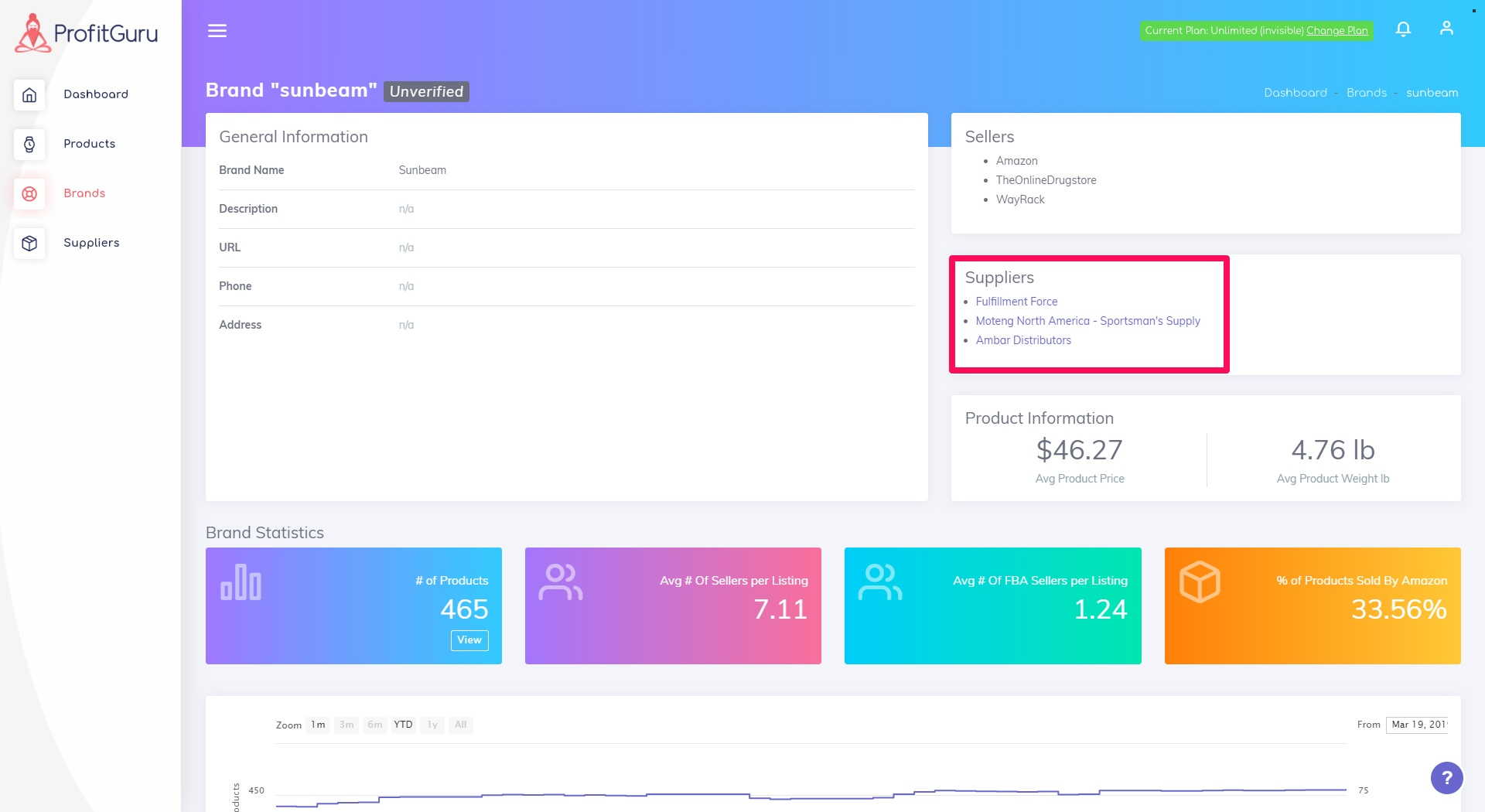
Once you click on a Supplier’s name, you’ll go to its dedicated page where you can see the types of products they supply and their contact details.
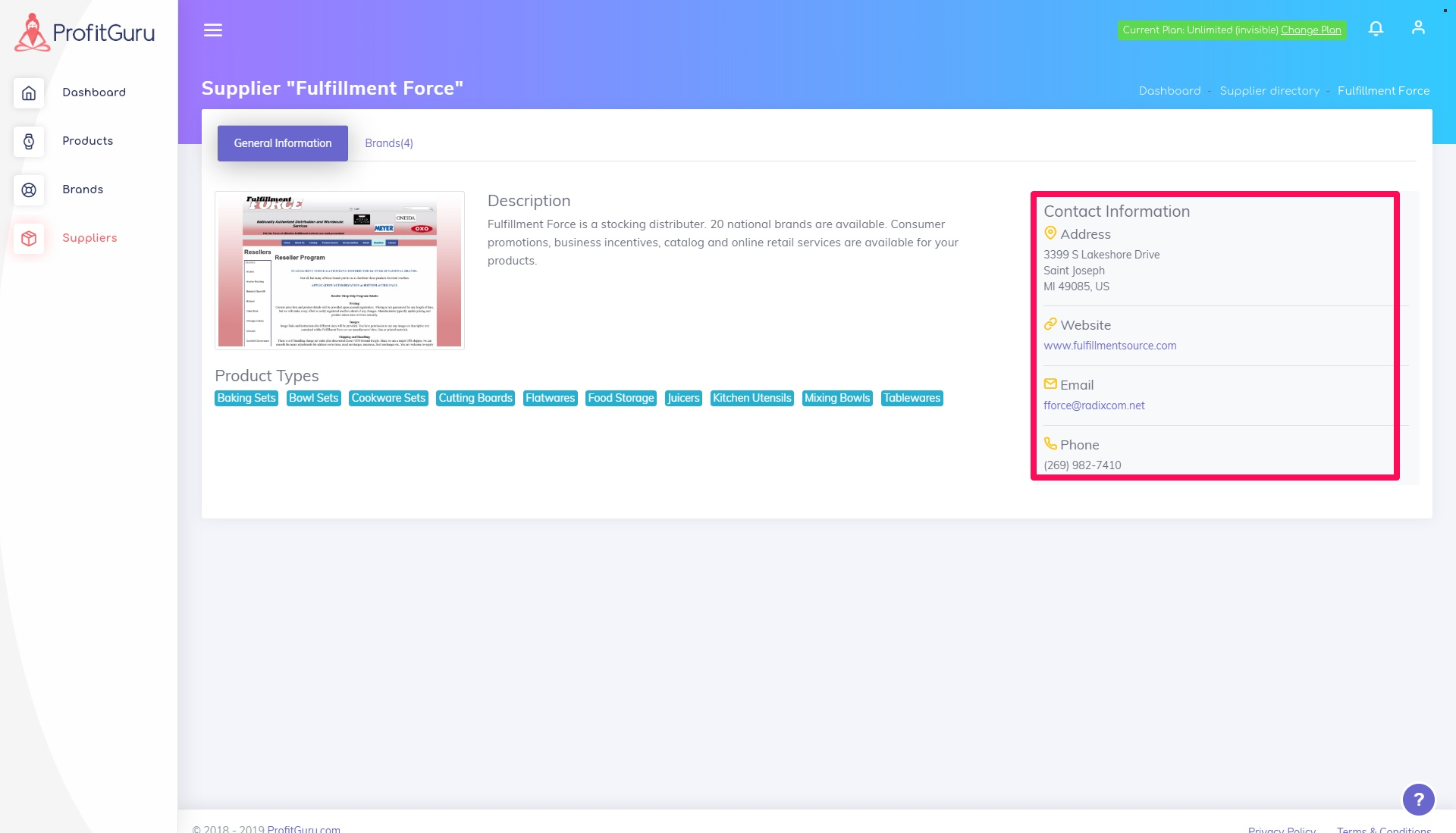
So within a few minutes, we have a good product to sell and a list of 3 potential suppliers to contact.
If you’d like to try this process yourself, you can sign up for ProfitGuru now.
How to negotiate deals and maximize your profit
Once you’re in contact with a supplier, it is important that you negotiate the best possible price with the wholesalers who you do business with because it is the cost which will ultimately determine if you make a profit or loss. Also, always remember that if you don't ask, you don't get!
If you are used to Retail Arbitrage, you will be aware that one of the first things that you do when looking at potential deals is to look for applicable coupon codes in order to obtain a discount.
You will be hard pushed to find coupon codes for decent wholesalers but there are a few other methods you can use which could enable you to purchase products at a lower price than the wholesaler is initially asking.
The negotiations will be easier if you have other sales channels besides Amazon and here is a great guide on Starting an Online Boutique.
1. Look for competing suppliers
Take the time to find other suppliers who are selling the same brand products. If you can find any, use that fact as a bargaining tool when negotiating the price of an order.
If your supplier knows that there is a good chance that you will go elsewhere if they cannot agree on a price with you, they will be more inclined to agree with your request because most frequently their priority is getting their sales volumes up.
2. End of month/year discount
Just as you will have targets to meet within your own business, so do your suppliers.
These could be end of month, end of quarter or end of year targets so you will sometimes find that they are more open to negotiation during these times than they might otherwise be.
3. Discount on volume
If you are making large orders, you will have more leverage when it comes to asking for a discount.
Don't underestimate the fact that your supplier will need to sell you stock as much as you need to purchase it at a good price so a large order can often persuade them to discount the total price.
Discounts can also be available at different pricing tiers when it comes to the buyer’s volumes.
In many cases, they are not advertised but your account manager normally has the freedom to give you small additional discounts right away.
4. Cash discount
It will obviously depend on suppliers but some will give a discount for cash purchases.
Be careful if going down this route and only deal with suppliers who you already have a relationship with or who you know are an established business.
5. Inquire about other offers
If you are trying to negotiate the price of a product which is in high demand, you may find resistance from the supplier because they know they will have no problem selling it at the advertised price.
A way around this is to inquire if they have any other stock which they could offer a discount on which could be included in the deal. The supplier may have stock of other products which they need to move and will let go at a discount, providing that you purchase the in-demand stock at the advertised price.
Check the products that the supplier is offering a discount on with ProfitGuru and you will often find that buying these products at a discount could be a potentially profitable opportunity.
6. Take advantage of NET Terms
If you are not familiar with NET terms, it is basically free credit from your supplier.
It is usually the case that when you make an order, it is either paid for at the point of purchase or on delivery.
With NET terms, you don't pay for the order until a later date. You will see NET terms such as “NET 30” or “NET 60” and the number basically means the number of days you have to pay for the order after the order has been made.
Don’t underestimate the value of a supplier who offers NET terms because it is free credit. Using NET terms, you could, in theory, order stock and pay for it after you have sold it.
But you should be aware that this technique has been the downfall of many a business.
If you don't have the means to pay for the stock and it doesn't sell as quickly as you expected, well, you can imagine the possible consequences.
If you are sensible though, taking advantage of NET terms is a great way of making the most of your cash flow.
7. Free shipping
Most suppliers are able to give free shipping if pushed even though it is not something which is always advertised. If they do refuse, ask what kind of purchase levels have to be reached for them to offer free shipping.
As an example, we were once told by a supplier that we needed to spend $100k in one calendar year in order to qualify for free shipping so we were able to plan accordingly as this would relate to a large monetary saving.
We qualified for free shipping and this offer stayed on our account even though we didn't spend that much the following year.
Even though you will probably not be spending that amount of money, you should still ask at what level they offer free shipping if they initially refuse your request.
8. Let them remember you for the right reasons
You should obviously be polite in all of your dealings with your wholesalers but if you are dealing in large volumes, it could be worth taking a few extra steps.
Nothing over the top - get to know them, find out which football team they support and send them a small gift.
They will be dealing with a large number of people in the course of their business and they will probably forget most of them. If they remember you for all of the right reasons it could very well pay you dividends in the future.
How to analyze supplier wholesale lists
Most wholesalers will be able to provide their customers with a product data file which can be analyzed with tools like SupplySpy.
If a supplier sends you a huge file with their product catalog, simply head over to SupplySpy.com and sign up for one of their plans.
Next, add the supplier name and import the product catalog using the “Import Products” button.
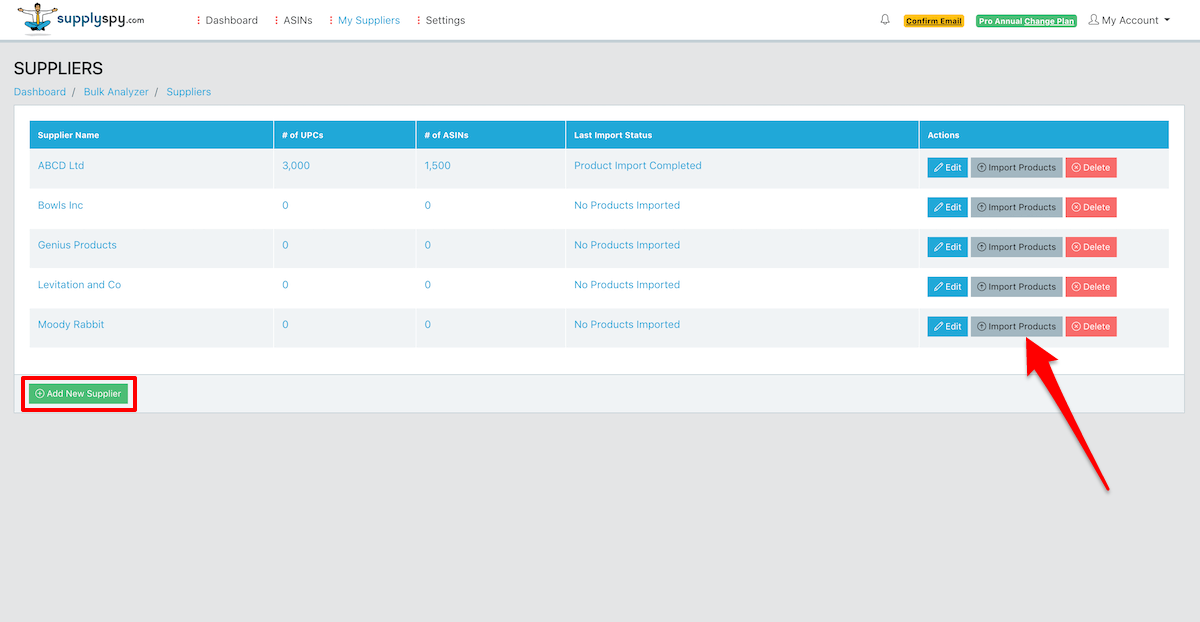
SupplySpy will analyze the supplier wholesale price lists and calculate your potential profits in bulk. This way, you don’t have to go through thousands of products manually and check their metrics one-by-one.
Even though there will only be a small percentage of products which will meet the recommended selling criteria, they will be easy to find. Watch this video to find out more:
Conclusion
So we’ve had a look at the Amazon supply chain for wholesale sellers and what you should look for when choosing a supplier. Always keep in mind that the best suppliers are the hardest ones to get.
With that in mind, how do you partner with strong suppliers?
First, you need to find them. Tools like ProfitGuru can help you tremendously here by reversing the supplier search process.
Instead of starting with a particular supplier and sorting through their whole product catalog, we recommend you to find popular products with high demand first. Then, reverse-engineer which suppliers stock these products (using the steps detailed above).
This way, you can shortlist great products and get their supplier contact details within minutes.
Now that you have a list of good partners, you should try and negotiate the best possible prices for your store. We covered 8 different tactics to do this such as asking for cash discounts and using competitor offerings.
But remember that you should always strive to provide value and move up the supply chain, aiming to work with brand owners directly. This is the surest way to get the best prices.
So there you have it - our take on how to find wholesale suppliers and negotiate profitable deals for your Amazon store.
Need more guidance? Sign up for our free course on building an Amazon store from scratch for beginners.
On this page
The Free Email Course to KickStart Your Amazon Journey
Getting from an idea to your first few sales in 7 days

